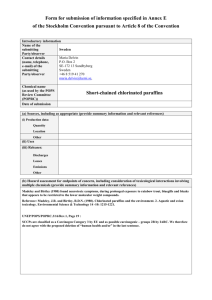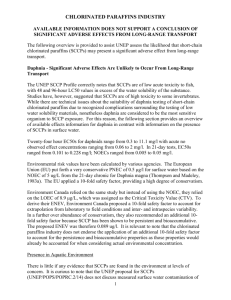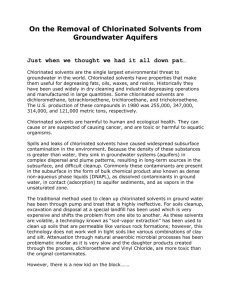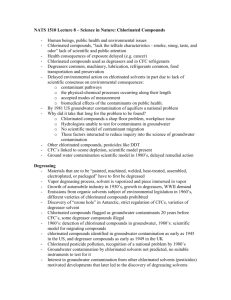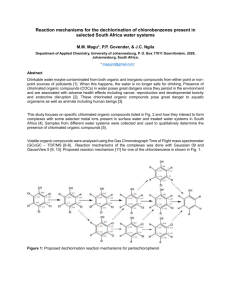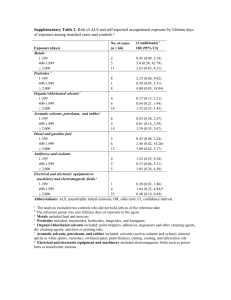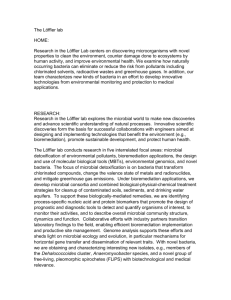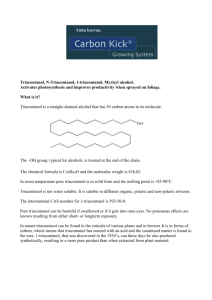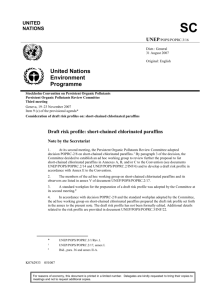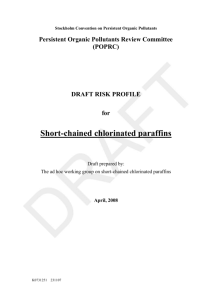Decision POPRC-2/8: Short-chained chlorinated paraffins
advertisement
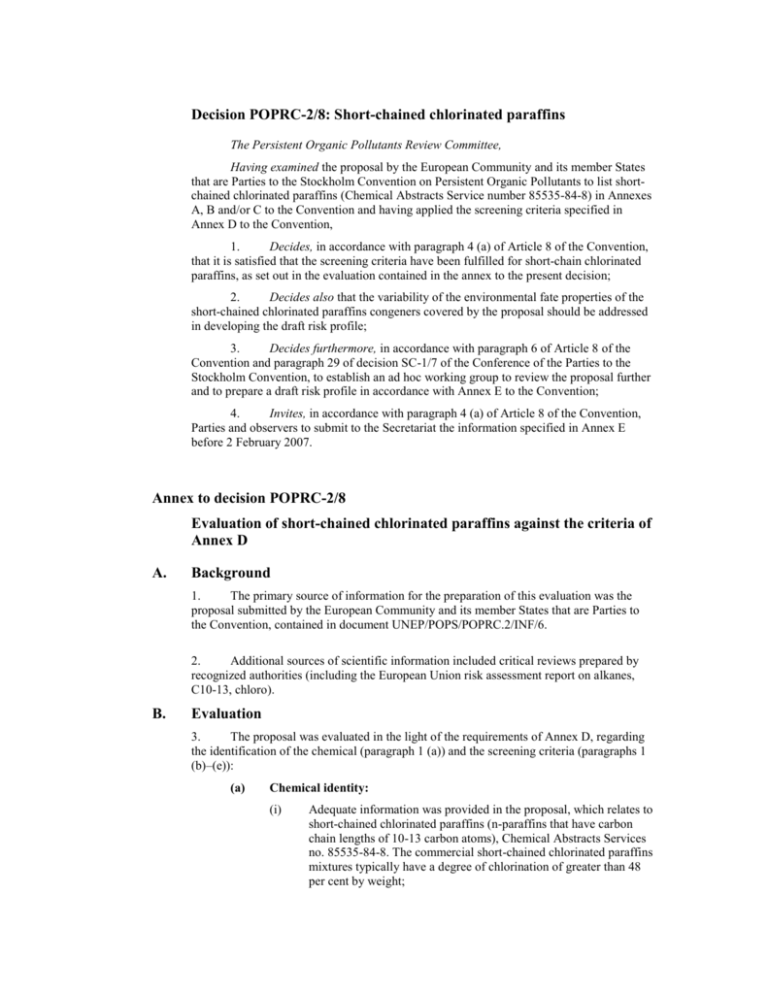
Decision POPRC-2/8: Short-chained chlorinated paraffins The Persistent Organic Pollutants Review Committee, Having examined the proposal by the European Community and its member States that are Parties to the Stockholm Convention on Persistent Organic Pollutants to list shortchained chlorinated paraffins (Chemical Abstracts Service number 85535-84-8) in Annexes A, B and/or C to the Convention and having applied the screening criteria specified in Annex D to the Convention, 1. Decides, in accordance with paragraph 4 (a) of Article 8 of the Convention, that it is satisfied that the screening criteria have been fulfilled for short-chain chlorinated paraffins, as set out in the evaluation contained in the annex to the present decision; 2. Decides also that the variability of the environmental fate properties of the short-chained chlorinated paraffins congeners covered by the proposal should be addressed in developing the draft risk profile; 3. Decides furthermore, in accordance with paragraph 6 of Article 8 of the Convention and paragraph 29 of decision SC-1/7 of the Conference of the Parties to the Stockholm Convention, to establish an ad hoc working group to review the proposal further and to prepare a draft risk profile in accordance with Annex E to the Convention; 4. Invites, in accordance with paragraph 4 (a) of Article 8 of the Convention, Parties and observers to submit to the Secretariat the information specified in Annex E before 2 February 2007. Annex to decision POPRC-2/8 Evaluation of short-chained chlorinated paraffins against the criteria of Annex D A. Background 1. The primary source of information for the preparation of this evaluation was the proposal submitted by the European Community and its member States that are Parties to the Convention, contained in document UNEP/POPS/POPRC.2/INF/6. 2. Additional sources of scientific information included critical reviews prepared by recognized authorities (including the European Union risk assessment report on alkanes, C10-13, chloro). B. Evaluation 3. The proposal was evaluated in the light of the requirements of Annex D, regarding the identification of the chemical (paragraph 1 (a)) and the screening criteria (paragraphs 1 (b)–(e)): (a) Chemical identity: (i) Adequate information was provided in the proposal, which relates to short-chained chlorinated paraffins (n-paraffins that have carbon chain lengths of 10-13 carbon atoms), Chemical Abstracts Services no. 85535-84-8. The commercial short-chained chlorinated paraffins mixtures typically have a degree of chlorination of greater than 48 per cent by weight; (ii) The chemical structure was provided; The chemical identity of short-chained chlorinated paraffins is adequately established; (b) Persistence: (i) There is one experimental study which examined biodegradability. Compounds with carbon number 12 and one chlorine (1chlordecone) were readily degradable under OECD test guidelines. Most other short-chained chlorinated paraffins, however, were resistant to degradation (Ref. 4). The weight of evidence indicates that the half-life of short-chained chlorinated paraffins in sediment is greater than 1 year (Refs. 1 and 2); (ii) Most short-chained chlorinated paraffin congeners are not readily or inherently biodegradable in standard tests. It can be concluded from simulation tests that short-chained chlorinated paraffins with low chlorine content (e.g. <50% wt Cl) may biodegrade slowly in the environment in the presence of adapted microorganisms. (Refs.1 and 2); There is sufficient evidence that short-chained chlorinated paraffins meet the persistence criterion; (c) Bioaccumulation: (i) The reported log Kow value of different short-chained chlorinated paraffins ranges from 4.39 to 8.69. The bioconcentration potential differs depending on the number of carbons and the number of chlorine atoms. High bioconcentration factors (BCFs) in fish have been reported. In fish, when the carbon number is 11 and the chlorine number is 7–10, the BCF values were as high as 11,000. Whole body BCFs of 1,173–7,816 have been determined in laboratory studies in fish, and an overall BCF value of 36,500 for C10-13 short-chained chlorinated paraffins have been estimated in situ for lake trout. Bioconcentration in mussels has also been assessed with reported whole body BCFs ranging from 5,785 to 40,900. (Refs. 1, 2, 3 and 4); (ii ) and (iii) Levels of short-chained chlorinated paraffins in marine mammals from various regions of the Arctic have been reported, as well as from Canada and Greenland. There is also evidence of shortchained chlorinated paraffins accumulating in fish species from Lake Ontario, Canada. Moreover, short-chained chlorinated paraffins have been detected in breast milk. (Refs. 1, 5, 6 and 7); There is sufficient evidence that short-chain chlorinated paraffins meet the bioaccumulation criterion; (d) Potential for long-range environmental transport: (i) and (ii) Atmospheric levels of total short-chained chlorinated paraffins reported in the Arctic environment ranged from 1.07 to 7.25 pg/m3 (Ref. 8). Occurrence of total short-chained chlorinated paraffins in Arctic surface sediments, marine mammals and fish has also been reported. (Refs. 1, 2 and 3); (iii) Atmospheric half-lives exceeding the screening criteria of 2 days (1.9–7.2 days) have been calculated from the reaction rate with hydroxyl radical concentrations in the atmosphere for short-chained chlorinated paraffins. A vapour pressure of 0.0213 Pa at 40°C has been assumed for a short-chained chlorinated paraffin with chlorine content of approximately 50 per cent. Henry's Law constants range from 0.7 to 18 Pa m3/mol. Water solubility ranges from 0.022 to 0.994 mg/litre. (Refs. 1 and 2); There is sufficient evidence that short-chained chlorinated paraffins meet the criterion on potential for long-range environmental transport; (e) Adverse effects: (i) There are no specific data available; (ii) There are animal data showing a potential of short-chained chlorinated paraffins to have adverse effects on human health, including effects on the liver and thyroid. In rodent carcinogenicity studies, dose-related increases in the incidence of adenomas and carcinomas were observed in the liver, thyroid and kidney. Although likely underlying mechanisms for these tumours suggests that they are not relevant to human health, short-chained chlorinated paraffins are regarded as possible carcinogens. The no observed adverse effect level (NOAEL) for induction of tumours is 100 mg/kg bw/day. Short-chained chlorinated paraffins are of high toxicity to a variety of aquatic invertebrates with no observed effect concentration (NOEC) values well below 0.1 mg/L. (Ref. 1, 2 and 3). There is sufficient evidence that short-chained chlorinated paraffins meet the criterion on adverse effects. C. Conclusion 4. The Committee concluded that short-chained chlorinated paraffins meet the screening criteria specified in Annex D. References 1. 2. 3. 4. 5. 6. 7. 8. UNEP/POPS/POPRC.2/INF/6. European Union Risk Assessment Report. Alkanes, C10-13, chloro (CAS No: 85535-84-8, Einecs No.: 287-476-5). Risk Assessment. Office for Official Publications of the European Communities, 2000. Filyk G., Lander L., Eggleton, M., Muir D. and Puckett K. (2003). Short-Chain Chlorinated. Paraffins (SCCPs) Substance-Final Draft II. Environment Canada. Dossier prepared for UNECE ad hoc Expert Group on POPs. Data peer-reviewed by the Chemical Products Council of the Ministry of Economy, Trade and Industry, Japan (www.safe.nite.go.jp/data/hazkizon/pk_kizon_data_result.home_data). Tomy, G.T. (1998). Environmental chemistry and toxicology of polychlorinated nalkanes. Reviews of environmental contamination and toxicology, 158:53-128. Muir, D., Bennie, D., Teixeira, C., Fisk, A., Tomy, G., Stern, G. and Whittle, M. (2001). Short-chain chlorinated paraffins: Are they persistent and bioaccumulative? ACS Symposium Series, 773:184-202. Thomas, G.O., Farrar, D., Braekevelt, E., Stern, G., Kalantzi, O.I., Martin, F.L. and Jones, K.C. (2006). Short- and medium-chain length chlorinated paraffins in UK human milk fat. Environment International 32:34-40. Borgen, A.R., Schlabach, M. and Gundersen, H. (2000). Polychlorinated alkanes in Arctic air. Organohalogen Compounds, 47:272-275.
